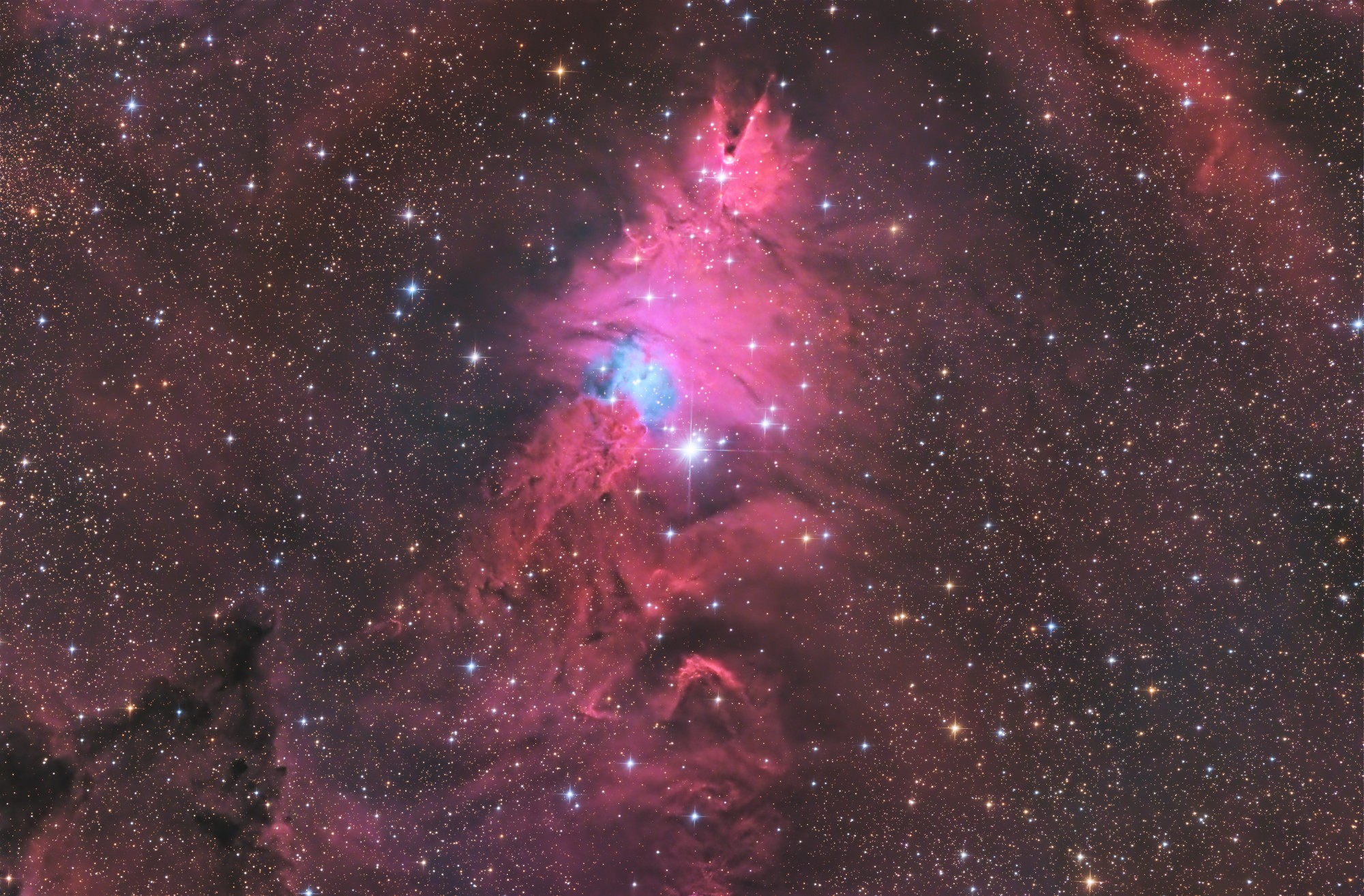No products in the cart.
The universe is a vast expanse of celestial objects that are intriguing to explore. Two such objects that catch the attention of astronomers and stargazers alike are the Cone Nebula and Christmas Tree Cluster. Both located in the Monoceros constellation, they are a sight to behold.
Introduction
The Monoceros constellation is home to several star clusters, nebulae, and other celestial objects. Among them, the Cone Nebula and Christmas Tree Cluster stand out for their unique features and breathtaking beauty. The Cone Nebula is a dark cloud of dust and gas, whereas the Christmas Tree Cluster is a young open star cluster.
The Cone Nebula
The Cone Nebula, also known as NGC 2264, is a star-forming region located in the Monoceros constellation. It is a dark nebula composed of dust and gas that blocks out the light of stars behind it. The nebula spans over 7 light-years and is about 2,700 light-years away from Earth. The Cone Nebula is shaped like a cone, hence the name, and it measures approximately 4 light-years in length.
Formation of the Cone Nebula
The Cone Nebula was formed from the gravitational collapse of a dense cloud of gas and dust. As the cloud collapsed, it gave birth to new stars, which are still forming in the region. The radiation and stellar winds from these young stars carved out the cone shape of the nebula by blowing away the surrounding gas and dust.
Composition of the Cone Nebula
The Cone Nebula is composed of hydrogen gas, dust, and other elements such as carbon and nitrogen. The gas and dust in the nebula are so dense that they block out visible light, making it difficult to observe the region. However, infrared and radio telescopes can penetrate the dust and reveal the structures within.
Significance of the Cone Nebula
The Cone Nebula is significant for its role in the formation of new stars. The dense gas and dust in the region provide the raw material for new star formation. The young stars in the nebula are still in the process of accreting material from their surrounding disk, growing in size and mass. Studying the formation and evolution of these stars can help us understand the early stages of star formation.
The Christmas Tree Cluster
The Christmas Tree Cluster, also known as NGC 2264, is a young open star cluster located in the Monoceros constellation. It is named after its shape, which resembles a Christmas tree. The cluster contains over 100 young stars, with an age of around 3 million years.
Formation of the Christmas Tree Cluster
The Christmas Tree Cluster was formed from the same cloud of gas and dust that gave birth to the Cone Nebula. As the cloud collapsed, it formed several new stars, including the ones in the cluster. The stars in the cluster are still in the process of forming, and some of them are surrounded by disks of gas and dust, which can give birth to planets.
Composition of the Christmas Tree Cluster
The stars in the Christmas Tree Cluster are mainly composed of hydrogen and helium, with traces of other elements such as carbon and oxygen. The stars in the cluster are relatively young and have not yet gone through the process of nuclear fusion, which will turn hydrogen into helium and release energy.
Significance of the Christmas Tree Cluster
The Christmas Tree Cluster is significant for its role in the study of star formation and evolution. The young stars in the cluster provide an opportunity to
study the early stages of stellar evolution, including the formation of protoplanetary disks and the development of planetary systems. By studying the properties of the stars in the cluster, astronomers can gain insight into the conditions that lead to the formation of stars and planets.
Observing the Cone Nebula and Christmas Tree Cluster
The Cone Nebula and Christmas Tree Cluster are both visible from Earth with a telescope or binoculars. They are located in the Monoceros constellation, which is in the southern sky during the winter months in the Northern Hemisphere. The best time to observe these objects is during the months of December and January, when the constellation is high in the sky.
Observing the Cone Nebula
To observe the Cone Nebula, a telescope with a large aperture is required to penetrate the dense dust and gas. Infrared and radio telescopes can also be used to observe the region. The nebula appears as a dark triangular shape with a brighter region at the tip, which is illuminated by the young stars within.
Observing the Christmas Tree Cluster
The Christmas Tree Cluster can be observed with a small telescope or binoculars. The cluster appears as a bright region with several stars of varying brightness. The shape of the cluster resembles a Christmas tree, with the brightest star at the top representing the tree’s star.
Conclusion
The Cone Nebula and Christmas Tree Cluster are two fascinating objects located in the Monoceros constellation. The Cone Nebula is a dark cloud of dust and gas that is actively forming new stars, while the Christmas Tree Cluster is a young open star cluster that provides a glimpse into the early stages of stellar evolution. Observing these objects can provide insight into the formation and evolution of stars and planetary systems.
FAQs
What is the distance between the Cone Nebula and Christmas Tree Cluster?
- The Cone Nebula and Christmas Tree Cluster are both located in the Monoceros constellation, but they are not physically close to each other. The Cone Nebula is about 2,700 light-years away from Earth, while the Christmas Tree Cluster is about 2,600 light-years away.
Can the Cone Nebula and Christmas Tree Cluster be observed with the naked eye?
- No, both objects require a telescope or binoculars to observe.
What is the shape of the Cone Nebula?
- The Cone Nebula is shaped like a cone, hence the name.
What is the age of the stars in the Christmas Tree Cluster?
- The stars in the Christmas Tree Cluster are around 3 million years old.
What is the significance of studying the Cone Nebula and Christmas Tree Cluster?
- Studying these objects can provide insight into the formation and evolution of stars and planetary systems.
Image technical:
- Starfield Optics 8″ Astrograph (native F4) http://bit.ly/3WOrKsf
- Starizona NEXUS .75 reducer/coma corrector for F3 https://bit.ly/3MCijaB
- QHY268M CMOS Camera (https://bit.ly/3Aj23FE), 26mp, 3.76um @ -10C
- QHY CFW3-L 7 position https://bit.ly/3IiYoxY
- Optolong filters (HaOIII-LRGB) https://bit.ly/3WQd5N7
- Skywatcher EQ6 mount https://bit.ly/3jEonpC / Skyshed Pier (Skyshedpod.com)
- Pegasus Astro Focus Cube https://bit.ly/2NDdEb2
- NINA 2.0 for acquisition https://nighttime-imaging.eu/
- Processed in PixInsight
- Seeing and transparency: average to good
- Total integration time: 3.5 hours (1min subs at high gain)
- Location: Kitchener, Ontario, Canada
Buying astro gear? Help support my efforts in bringing the astro community new content (videos, tutorials, tips, reviews) by using these affiliate links to purchase astro equipment. I’ll receive a small commission at no cost to you.
Ontario Telescope (Canada)
All-Star Telescope (Canada)
New to Pixinsight image processing? Get in touch! I provide one-on-one lessons via Zoom.
You can also buy me a coffee via…
https://paypal.me/visibledark or https://www.buymeacoffee.com/visibledark

My story began more than 40 years ago looking up at the Moon with a small telescope my Father had. Encouraged by my parents, who bought me my very own telescope, a 4.5″ reflector, I began to explore the night sky from my family home backyard. Today I do astrophotography from my home in Kitchener, Ontario and also with remote telescopes located in New Mexico and Australia. Some of my images have won awards and have been featured online and in magazines.



Leave a comment...